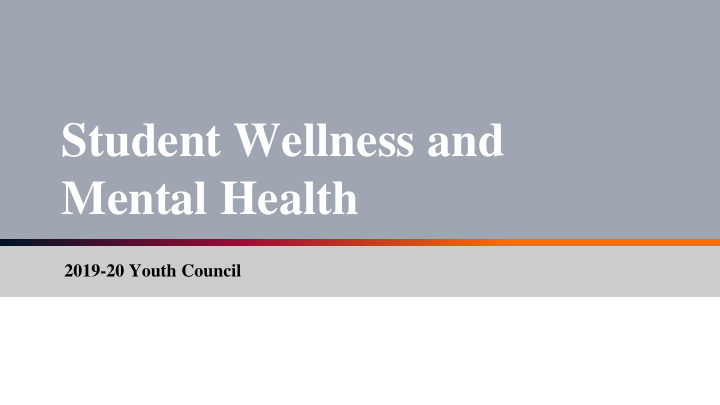



Student Wellness and Mental Health 2019-20 Youth Council
WHO WE ARE
October 19, 2019 Youth Council Meeting
Julie Patton
Nate Bergen
Olivia Maurice
Mental Health Stigma 7
What is Stigma? 8 ▹ Stigma is a negative stereotype that has surrounded the topic of mental health. Those who suffer from mental illness say that the stigma attached to the topic has only made their struggles worse.
How is Stigma Affecting Students? 9
Statistics 10 ▹ 50% of mental illness begins at age 14 ▹ Only 1 out of 5 children will receive proper mental health treatment ▹ Suicide is the second leading cause of death among Canadian youth ▹ Canada has the third highest suicide rate in the world ▹ This accounts for 24% of deaths among those aged 15-24
How Can We Fight Stigma? 11 ▹ Educate students on what mental health is ▹ Create organized groups that make students feel involved (SRC, clubs, YAC – Youth Alliance Circle) ▹ Taking input of students on their homework load ▸ Schedules and needs can both vary
How Can We Fight Stigma? 12 ▹ Be empathetic and open-minded when listening to someone who may be dealing with a mental illness ▹ Create a safe environment for students
Physical Environment and Mental Health 13
Importance of School Environment 14 ▹ Students spend 6-7 hours in school daily ▹ Environment may promote or deny: ▸ Stress management ▸ Ability to focus ▸ Happiness ▹ Positive environment accommodates wellbeing ▹ Students should feel safe, motivated and engaged in a positive school environment
Building a Positive Environment That supports the well-being of students 15
What students need from school environment 16 Productivity Creativity Tranquility
Space for productivity 17 ▹ Minimal distraction ▹ Resources ▹ Preferred supports: ▸ Listening to music ▸ Fidgets ▸ Stability balls
Space for creativity 19 ▹ Displayed artwork ▹ Space to move ▹ Tools: ▸ Instruments ▸ Art supplies ▸ Mentoring
Space for tranquility 22 ▹ Silence ▹ Calming activities ▸ Drawing ▸ Colouring ▸ Reading ▹ Areas to reflect and relax
The other images of tranquil spaces
Techniques for Stress Management Coping skills that can help students 25
Coping with Stress and 26 Anxiety ▹ Aromatherapy ▹ Journaling ▹ Nature ▹ Square breathing
Coping with Stress and Anxiety 27
Negative Environments 28 ▹ Restriction of things that help students ▸ Fidgets, headphones, taking breaks, moving/standing while working ▹ Excessive distraction ▹ Plainness - trying to stray away from your typical “desk and chair” classroom ▹ Lack of resources and inspiration
Summary 30 ▹ Mental well-being is a concern for everyone ▹ Schools should: ▸ Accommodate strategies and activities to cope ▸ Provide spaces that promote: ⬩ Productivity ⬩ Creativity ⬩ Tranquility ▹ Make classrooms fun and interesting
Connections A student’s network of support 31
Four Types of Connections 32
Multicultural Education and Mental Health 33
Access to language, spirituality and culture is a right. Not a privilege. 34
Importance of Multicultural Education 35 ▹ Insufficient exposure to various cultures ▸ Leads some students to believe they are the norm ▸ Reinforces the notion that one culture is mainstream ▸ Lays the foundation for students to develop prejudice
Importance of Multicultural Education 36 Proper representation of culture: ▹ Nurtures sense of identity and belonging ▹ Makes a student feel valued ▹ Benefits academic success ▹ Allows all students to flourish
Multiculturalism and Mental Health 37 ▹ Students who belong to a minority may suffer from discrimination and prejudice ▹ Suicide is approximately twice as prevalent in Indigenous communities as in Canada as a whole ▹ In Saskatchewan, the rate of suicide for children aged 10- 19 is: ▸ 6 times higher for First Nations boys that non-First Nations boys ▸ 26 times higher for First Nations girls than non-First Nations girls
Incorporating Diversity in Education 38
Minahik Waskahigan High School 39 ▹ Cultural Days ▸ Trying the activities and cuisine of other cultures ▹ Elders’ gatherings ▸ Tents with different activities ▸ Entertainment in an arena ▸ Cultural foods ▸ Storytelling by Elders
Creighton Community School 40 ▹ Incorporation of cultural learning in curriculum ▸ Indigenous history incorporated in multiple subjects ▸ Native Studies 20/30 ▸ Optional Cree classes grades 4-12 ▹ Teaching students about the backgrounds of their classmates (e.g., Ukrainian) ▸ Students help the teacher teach ▸ Parents volunteer to host cultural activities ▹ Encouraging students to explore their cultural background in their artwork ▸ Have art exhibits inside of teepees ▹ Cogwagee Therapeutic Running Group ▸ Grade 4-6 First Nations/Métis students, in accordance with the youth/sport Calls to Action from Truth and Reconciliation ▸ Purpose is to run together to learn coping skills and build resilience (cognitive behaviour therapy, mindfulness)
École Valois 41 ▹ Focus on francophone culture ▹ Activities: ▸ Carnaval d’hiver ▸ Le tintamarre ▸ Cuisine Québécoise ▹ Courses ▸ Français fransaskois 10/20/30 ▸ Sciences sociales fransaskois 20/30 ▹ Language courses offered online ▹ Annual division-wide events held in French and hosting public events in French
Bert Fox Community High School 42 ▹ Course Offerings ▸ Cree Culture Program 10/20 ⬩ Cree teacher with experience with his own culture ⬩ Students perform Experiential Learning (Hands On Work) often ▹ Northern Lifestyles / Astronomy ▹ Learning From The Land ▹ Culture Arts ▸ Learn the art of many diverse cultures
Ways to Improve 43 ▹ Culture-based education for Indigenous students ▹ Using experiential learning ▹ Northern Exposure Trips (NET) ▹ Use of proper knowledge keepers ▹ Performing different cultural practices to better understand ▹ Treating exposure to other cultures as a principal aspect of education as a whole
See us, hear us – before it’s too late. ” 44
Any questions?
Recommend
More recommend